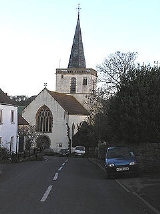
Church of St Andrew, Stogursey
Encyclopedia
The Church of St Andrew in Stogursey
, Somerset
, England which dates from the early 12th century and has been designated as a Grade I listed building.
The church of St Andrew, was built by William de Falaise, as a Benedictine priory church, around 1117 though it is believed to incorporate earlier features. It was given to Abbey at Lonlay near to Falaise
. A small community of monks then settled in Stogursey forming the Priory of St. Andrews of the Ards
, which the church served.
The church was enlarged around 1180 when the apses were demolished and the chancel
extended. The priory was dissolved around 1440, and it became a parish church. It was further altered in the 15th century, the nave was extensively restored 1824 by Richard Carver and the chancel rebuilt between 1863 and 1865 by John Norton. The interior contains two Norman
fonts
.
The tower holds six bells the oldest of which dates from 1611.
The parish is part of the Quantock Coast benefice
within the Quantock deanery.
Stogursey
Stogursey is the name of a small village and civil parish in the Quantock Hills in Somerset, England. It is situated from Nether Stowey, and west of Bridgwater...
, Somerset
Somerset
The ceremonial and non-metropolitan county of Somerset in South West England borders Bristol and Gloucestershire to the north, Wiltshire to the east, Dorset to the south-east, and Devon to the south-west. It is partly bounded to the north and west by the Bristol Channel and the estuary of the...
, England which dates from the early 12th century and has been designated as a Grade I listed building.
The church of St Andrew, was built by William de Falaise, as a Benedictine priory church, around 1117 though it is believed to incorporate earlier features. It was given to Abbey at Lonlay near to Falaise
Falaise, Calvados
Falaise is a commune in the Calvados department in the Basse-Normandie region in northwestern France.-History:The town was the birthplace of William I the Conqueror, first of the Norman Kings of England. The Château de Falaise , which overlooks the town from a high crag, was formerly the seat of...
. A small community of monks then settled in Stogursey forming the Priory of St. Andrews of the Ards
Priory of St. Andrews of the Ards
The Priory of St. Andrews of the Ards was a Benedictine Abbey at Stogursey in Somerset.Originally the area was known as Stoke and by 1086 was owned by William de Falaise following the Norman Conquest. He who had recently married Geva, daughter of Serlo de Burci, and widow of Martin "de Wallis"...
, which the church served.
The church was enlarged around 1180 when the apses were demolished and the chancel
Chancel
In church architecture, the chancel is the space around the altar in the sanctuary at the liturgical east end of a traditional Christian church building...
extended. The priory was dissolved around 1440, and it became a parish church. It was further altered in the 15th century, the nave was extensively restored 1824 by Richard Carver and the chancel rebuilt between 1863 and 1865 by John Norton. The interior contains two Norman
Norman architecture
About|Romanesque architecture, primarily English|other buildings in Normandy|Architecture of Normandy.File:Durham Cathedral. Nave by James Valentine c.1890.jpg|thumb|200px|The nave of Durham Cathedral demonstrates the characteristic round arched style, though use of shallow pointed arches above the...
fonts
Baptismal font
A baptismal font is an article of church furniture or a fixture used for the baptism of children and adults.-Aspersion and affusion fonts:...
.
The tower holds six bells the oldest of which dates from 1611.
The parish is part of the Quantock Coast benefice
Benefice
A benefice is a reward received in exchange for services rendered and as a retainer for future services. The term is now almost obsolete.-Church of England:...
within the Quantock deanery.

